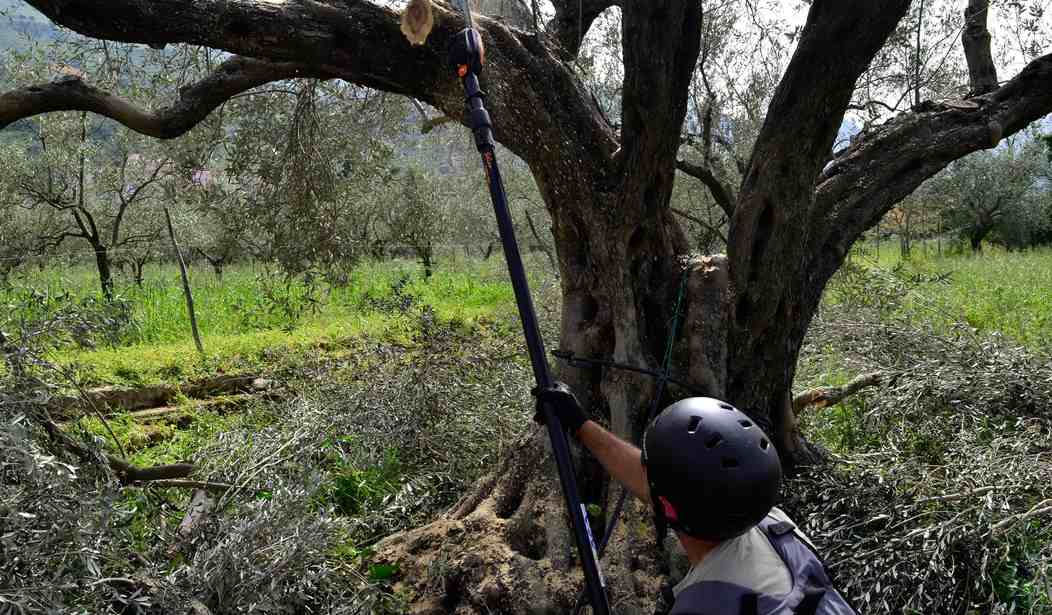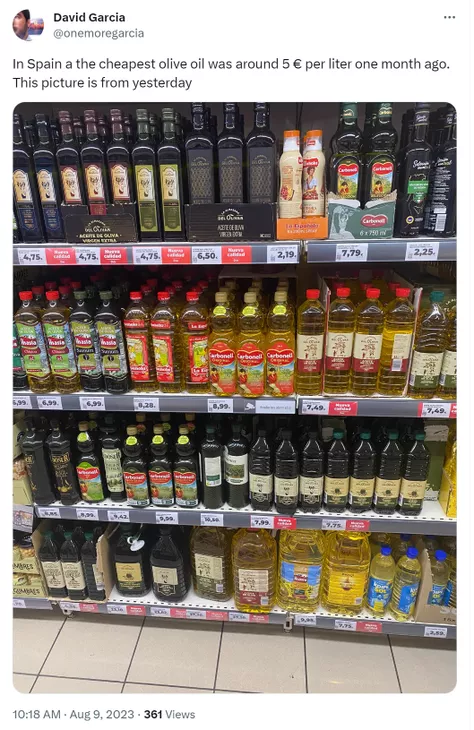Top News
Green gold, Aegean tea: Olive oil

Back in February I told y’all I’d heard there were some potential problems ahead with the olive oil crops out of the Mediterranean. It was awful dry in Greece, Spanish production was down, and the catastrophic earthquakes and on-going recovery were hampering what could have been robust Turkish and Syrian production.
The price per metric ton was already approaching $5900 months ago.
Fast forward 6 months to now, and *gulp*
That’s looking pretty quaint.
COLUMN: My very personal oil shock — olive oil, that is.
How bad is it? Last week, the benchmark wholesale price of extra virgin olive oil surged to an all-time high of $8,500 per metric ton, more than double a year ago.#aceitedeoliva | @Opinion
Link: https://t.co/qYWvmB6qkh pic.twitter.com/LD6HoLts45— Javier Blas (@JavierBlas) August 9, 2023
I know we’re growing some pretty good stuff here in the States – we all had a great talk about it in the comments on the other post. But if you’re a bulk extra virgin olive oil use household like we are, those delicious but DANG IS THAT MONEY American brands just won’t cut it for something you use every day. I love Spanish and Greek olive oil. We’ve got a Greek family in town who produces and brings their own in from the country and it’s absolutely lovely. But that price had already been on the rise and I can’t imagine where it is now for one of their 3L tins, which is what we usually buy. I have several already, so it’s not critical, but that’s the other problem with olive oil.
It’s adverse to hoarding. The compounds that give it that lovely perfume are too volatile, and go off – or rancid – much quicker than more stable oils.
My fondness for indulging in the Spanish version may soon be out of reach.
…Spain’s southern region of Andalusia, the Saudi Arabia of olive oil, accounting for about one-third of the global supply, is the epicenter of the crisis. The Phoenicians introduced the olive tree millennia ago there, and then Romans turned the region into a plantation. Today, Spain devotes an area roughly the size of Massachusetts to growing olive trees and produces about half of the world’s output.Spain — Andalusia in particular — has been facing a drought for the last two years, likely exacerbated by climate change. In the current 2022-23 crop year, production plunged to about 663,000 metric tons, down 56% from the 2021-22 level. The collapse, coupled with low production in Italy, where a pathogen is killing olive trees, dragged global output to 2.62 million tons, down nearly a quarter from the previous year. As demand has risen, global inventories have plunged, with the stocks-to-use ratio falling to 12.1%, the second-lowest level in more than 50 years.

And it seems like it’s not just an issue of dry weather, either. Something is killing trees in Italy – a bacterium named Xylella fastiodiosa. It has no known cure, is spread by spittle bugs who, when they eat the leaves, carry it from tree to tree in their mouths. Chasing the pathogen has been so frustratingly (dare I say) fruitless, and the toll has been so great, that the Italians are now training dogs to sniff out infected trees. An infected tree’s metabolism changes and gives off a different scent, and so, like hunting for truffles, finding the sick tree is the prize the dog hunts for, before it can kill others.
…There are no known cures for this disease, and once infected, the plant slowly dries up (though some infected plants manage to survive without showing symptoms). There are several strains of Xylella, and together they affect 595 plant species worldwide at the last count. Over the past century, Xylella has decimated orange fields in Brazil, vineyards in southern California, and pear trees in Taiwan. Then, 10 years ago, Xylella reached Puglia’s olive trees.
With its 60 million olive trees, Puglia used to produce up to 50% of Italy’s olive oil, but in just a few years, Xylella infected and killed 21 million trees, many of which were several centuries old.
Today, an endless sea of dead, grey tree trunks covers the lower part of the region, dotted with what’s left of thousands of small-scale farms, olive mills, and greenhouses.
Mauro Giuranna, the owner of Vivai Giuranna, has personal experience of a Xylella attack. When plant inspectors found infected plants in his greenhouse, he had to dispose of about €1m ($1m/£900,000) worth of plants.
Some of those Italian trees were unbelievably old. What a tragedy.
Traders are gloomy prognosis-wise and it doesn’t help that Turkey’s recovery won’t mean more olive oil on the market. Erdogan restricted exports trying to control food price inflation at home..
…Looking ahead, the 2023-24 harvest does not seem promising. Production in Spain is projected to reach just 737,000 tons, half the usual quantity. Similarly, Italian and Greek producers do not expect significant improvement. Unusually warm spring temperatures and a prolonged period of dryness and heat in southern Spain have adversely impacted olive tree growth and fruit set.
With already critically low olive oil stocks, another crop failure in southern Europe would result in unprecedented demand destruction and significantly higher prices. In fact, there is speculation that wholesale prices could surge to as high as $10,000 per ton. Hoarding olive oil, as some families have done, would only exacerbate the situation.
It’s one thing after another lately.
Read the full article here


















